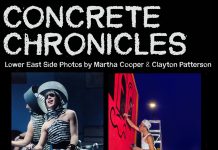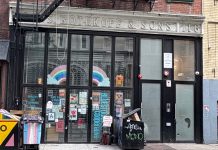
Home is where your stuff is. In Bryan Zanisnik’s latest installation, Every Inch A Man, at Abrons Art Center, he has mined material from his childhood home as well as Abrons’ vast basements to create a magically cluttered world filled with memories. A hoarder’s dream come true in vivid color, the exhibit conjures the secret spaces of childhood: attics, basements and garages where one’s old favorite toys were discarded. Zanisnik reigns at its center, trapped in a clear plastic case — crumpled two dollar bills and old baseball cards around his feet, reading Philip Roth’s arguably failed classic The Great American Novel.
Successfully portraying the absurdity of failure is something Zanisnik does with pathos and spectacular visual effect. He has elevated these lost objects, dredging them up from their shadowy hiding places, making them important once again. On a sunny day last week, I sat down with Zanisnik on a bench on Orchard Street to discuss the Freudian depths beneath his work, childhood memorabilia, his parents role in his art, Philip Roth and New Jersey.
ROYAL YOUNG: I want to start by talking about your personal background and family life. Tell me where you come from.
BRYAN ZANISNIK: I grew up in New Jersey. In a lot of my work I build these kind of hoarding, entropic spaces. My parents’ house is actually quite minimal. If you go into the living room, the den, the bedroom – it’s like a table, a chair, big white ceilings. What’s amazing is the garage and basement, which is all the excess from my childhood, my brother’s childhood, from their past and it becomes these rooms of floor to ceiling detritus and memorabilia. I’ve always been interested in those spaces.
YOUNG: What (interests you) about them?
ZANISNIK: For me, they became museum-like spaces. Another experience I had when I was 29, was spending a summer residency in Maine and I would go to these Americana museums. Rather than a museum in New York, you would have a collection of a family’s taxidermy or gems displayed in floor to ceiling manner with no hierarchy of importance, the way you would see in a more traditional or urban art museum. That interested me in the same way the spaces in my parent’s garage interested me. Using my family in my work is something which goes back to my childhood.
YOUNG: My dad is an artist and his dad’s house in Springfield, Illinois looked like a motel room. There was nothing on the walls. It was so bare. So I’m really interested in the relationship between the bare walls and the spaces where there are a lot of memories. Do the cluttered spaces filled with objects feel more warm and welcoming to you?
ZANISNIK: They feel more about history and memory. The other spaces feel neutral. Even if the basement and garage is overwhelming and kind of scary as if you might get buried alive, there is an implicit history and memory. That to me is what resonates. That is also one of the reasons I was interested in doing this project at Abrons. One of the challenges of Abrons is that it is so not a neutral space. It’s not Chelsea. It’s not white walls, square room, high ceilings.
What interested me is their unusual architecture, these kind of concrete waffled ceilings and dated brick interior. It felt like more of a Cold War fall-out shelter than it did a gallery. Rather than going the typical route of trying to neutralize or ignore it, I wanted to bring attention to that. So while most of the walls and floor are hidden, I left the waffled ceiling exposed. It was really important to me to bring emphasis to that peculiar-ness. It also brings attention to the history of the space.
YOUNG: It seems like the history of space is a running theme.
ZANISNIK: It really is. The objects that appear throughout Abrons come from two separate but overlapping trajectories. They either come from my childhood home like Billy Baloney, this doll I had as a little kid who was frightening then and even more frightening now. There’s this shirt I wore to a Gwar concert as a teenager that’s covered in fake blood, baseball cards, comic books.
Then there’s the other history, which is objects pulled from Abrons storage spaces. Abrons, like my parents’ home, has basement upon basements. So I started mining that, bringing up those objects and placing them within the space. So it’s an institutional archive, a personal archive and how they cross. They blend into one another, become diffused and I like that ambiguity.
YOUNG: What do you think these hidden spaces say about people and what are you looking for in them?

ZANISNIK: I’ve always been very interested in Freudian psychology. These become the murky subconscious, what lies beneath the surface. So there’s a very psychological read to it, but I’m also interested in these objects having a dual significance and insignificance. They’re significant enough to be stored, but they’re haphazardly thrown in corners, piled upon each other, damaged, scarred. It also plays to this interest I have in failure.
YOUNG: What about failure interests you?
ZANISNIK: I’m interested in the absurd and I feel failure often plays a big role in the absurd.
YOUNG: Do you think failure is harder than success?
ZANISNIK: I’m more suspicious of success because there’s an implicit self-importance or grandiose in it that I like to stay away from. In my work I like to embrace, if not a humbleness, a pathetic quality. In collaborating with my parents, who both have no art background—my dad is in printing and my mom is a schoolteacher—there’s a poeticism in them engaging in the work with me, a Freudian subtext and a pathetic element in having these two elderly people being forced to do things at art openings. These elements seem tied to a more complex and interesting psychology than success, which seems more about posturing and I feel is more one dimensional.
YOUNG: Why Philip Roth?
ZANISNIK: When I began taking an interest in Roth, it was for a very superficial reason: he writes about New Jersey and is from New Jersey and I’m from New Jersey. Though I love living in New York, I still have a real fascination with New Jersey. But beyond that, he has interests, in this novel in particular in baseball, Americana, abject masculinity, and failed protagonists. But in particular I chose The Great American Novel, because it’s often considered one of his failed works.Right now it’s somewhat out of print. Outside of anthologies there are
not many copies in active circulation. I bought a first edition from the early ‘70s online. I was interested in a work by an iconic author, but a forgotten work.
YOUNG: When you are going back through these childhood objects, is there an involuntary emotional reaction?
ZANISNIK: More than emotional, there’s an unexpected rush of recollection and memory, that to me is more frightening than anything else, because they lay dormant in my subconscious.
YOUNG: Why frightening?
ZANISNIK: Because it makes me aware of how much material lays dormant from our childhood or past that’s a part of us, even if we’re not daily aware of it.
Bryan Zanisnik: Every Inch a Man continues at Abrons Arts Center (466 Grand Street) through May 6th, 2012. Weekly performances are Thursday – Sunday, 1pm – 6pm.
;









